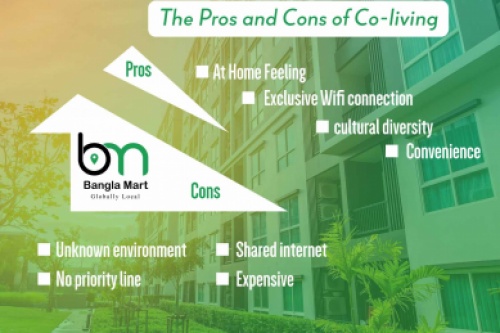The Future of Co-Living: A Few Steps To Understanding
Co-living is a term used to describe people who live together in a shared space. Co-living spaces are available in a wide range of designs and sizes. Some are shared houses that strive to keep residents as close as possible, while others provide individual apartments with common living areas where residents can gather whenever they wish.
A survey report says that by 2050, 2.5 billion people will be living in cities, with 90 % of the population living on only 10 % of our land's surface.
A Few Points To Note For A Better Future Search Of Co-Living
1.Nearly 72% of millennials would consider living in a coliving facility, according to a survey conducted in numerous cities.
2.The emergence of coliving and analogous housing was influenced by the financial crisis of 2007–2008.
3.The number of millennials living with roommates increased by 39% between 2005 and 2015.
4.Additional Point: According to the report, 55 % of 18–23-year-olds were willing to spend $10,000–15,000 each month for co-living.
The Pros and Cons of Co-living
Pros
1. A fully equipped place to stay that feels more like a home than a hotel.
2. It's a fantastic opportunity to meet new people, exchange ideas, and be inspired by those in your field.3. Good WiFi is required in most co-living spaces.
4. When you arrive at plug-and-play living, everything is set up and ready to go.
Cons
1. Getting enough sleep can be challenging when you live with people.
2. You'll need to be flexible about things like watching TV or listening to music because common rooms are shared.
3. Having a lot of individuals on the wifi can slow down a connection.
4. Co-living costs more than hostels and traveling options in general.
The 4 Most Important Benefits Of Co-Living Are Listed Below
1.Rent is the most expensive monthly expense for people under the age of 30, accounting for 45 % of their income on average.
2.Once you've signed the lease on a new home, your workspace isn't done: You'll need to set up utilities and budget for monthly payments for things like internet and gas.
3.Making friends as an adult can be challenging, especially if you're transferring to a new location or are focused on your career.
4.Coliving is a fantastic alternative if you don't want to commit to a long-term lease (let alone buy furnishings and appliances for a home you might only live in for a year).
Bonus Point: According to a 2019 poll, 30% of Millennials use social media "frequently" or "often."
Future Of Co-Living Trends That Will Be Most Effective For You
1.Create a shared future for everybody.
2.Technology for Co-living .
3.Creating Communities with a Purpose.
4.Design and construction of co-living spaces
Things You Should Do With Your Co-Living Spaces In The Future
Co-housing will evolve and change in the future. As a result of cultural changes, it may become more prominent and popular, and we anticipate the hospitality industry will follow suit. You should pick your sites more carefully.
Extend their product line and price points to appeal to both short and long-term visitors. To make people's lives easier and more convenient, develop new services and evolve.
The Co-living Experience: Final Thoughts
Young people, distant workers, digital nomads, and those who need to live and work in cities are increasingly interested in co-living. There are numerous types of co-living and a diverse choice of co-living venues to choose from!
In this guide, we've covered all you need to know about co-living, including how to choose the best co-living option for you! For further information, go to this link: https://www.banglamart.com/contact/












 Choosing the Right Fasteners for Your Project
Choosing the Right Fasteners for Your Project



